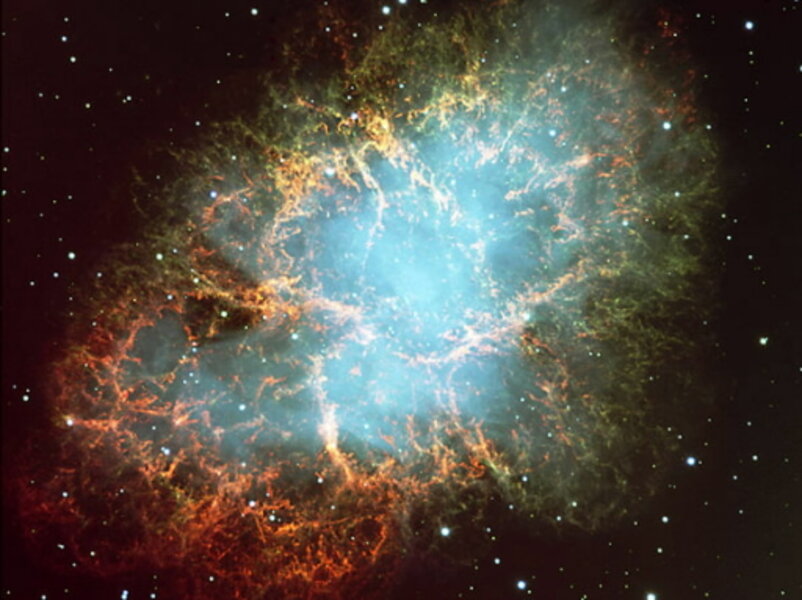King Midas in space? Rare star collision produces gold.
Loading...
Brides and grooms have stars not only in their eyes, but also in their wedding bands, scientists have found.
Researchers at Harvard University say they have observed an unusual astronomical event that sends gold flying into space. A similar event could have been responsible for the glittering metal's presence on Earth.
Most of the lighter elements found were created within stars, as a byproduct of nuclear fusion. When those stars exploded at the end of their lifecycle, they shot elements like calcium, iron, and carbon into the universe. Those star-created elements and others would join with hydrogen and helium originating from the Big Bang to become the building blocks of our world, and of our bodies: the calcium from star explosions is in our bones; the iron is in our blood; and the carbon is in our DNA.
But simple star death does not explain how the elements heavier than iron, including gold, arrived here. Those elements cannot be made in the typical star’s artisan laboratory. Among the leading candidates for the birth of those metals is a supernova, the cataclysmic explosion of a white dwarf star, believed to happen just three times every century in our entire galaxy.
Now, a team of Harvard astronomers has for the first time offered data supporting an alternative idea: gold is instead created in an even rarer event, the merger of two unusual stars, called neutron stars.
“It's widely said that gold may originate in supernovae, or explosive star deaths, but this is still debated within the scientific community,” says Wen-fai Fong, a graduate student at the Harvard-Smithsonian Center for Astrophysics and one of the researchers on the project, in an email interview. “This potential discovery provides an alternative, and perhaps dominant, mechanism for gold production.”
She noted that the two ideas are not mutually exclusive, and gold could be produced in both events.
As a star's core is compressed during a supernova, it collapses into an extremely dense object called a neutron star. These remnant stars – there are about 2,000 known to be in our galaxy – have masses of 1.4 to 3.2 times that of our sun, but all that mass is packed into a space less than 15 miles wide. By comparison, the sun is 864,938 miles wide.
It is now possible that it takes a collision of two neutron stars to create gold, one of the rarest elements in the universe.
“The production of heavy elements, such as gold, should accompany every neutron star merge,” says Ms. Fong.
Neutron stars orbit each other in twos. As their energy wanes over time and as their orbits shrink, the stars eventually collide in a booming event that is estimated to happen only once every 10,000 to 100,000 years per galaxy, says Fong.
Less than one percent of the materials flung out into space in the cataclysm are heavy metals. And just a fraction of those heavy metals are gold, said Fong.
But that fraction is an incredible volume – in the prodigious event, about 10 moons worth of gold was created, showering surrounding space as though it had been singed by King Midas’ fingers.
The findings, due to be published in the Astrophysical Journal Letters, come after researchers last month identified what is known as a short gamma-ray burst, or a flash of light from an explosive event happening light years afield from us. This burst, called GRB 130603B, originated at a distance of 3.9 billion light-years from Earth, and is one of the nearest bursts to us ever recorded.
The flash lasted for just two-tenths of a second, but GRB 130603B then offered researchers a slow fade of mostly infrared light. That afterglow did not in brightness or behavior match the usual one that follows such a burst, as a high-speed jet of particles smashes into the gas surrounding the exploding object.
Instead, that glow was the telltale signature of radioactive elements undergoing radioactive decay. Those elements had been cooked-up in the neutron-rich exploded material.
Since this studied collision happened in a distant galaxy, the specific gold it produced is not actually the metal in our earthly products. Our resident gold was likely formed in similar events closer to Earth.
“The gold produced in this event (and others like it) is identical to what we have on Earth,” said Edo Berger, a professor of astronomy at the Harvard-Smithsonian Center for Astrophysics and the lead researcher on the project, in an email interview.
“Similar events in our galaxy prior to the formation of the solar system enriched the galaxy with gold,” he said. “The solar system then formed out of this material and the gold made it into the Earth.”






